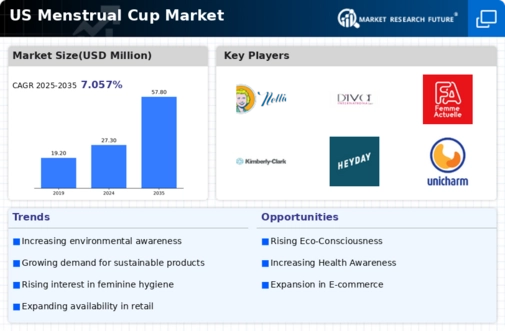Increased Health Awareness
the menstrual cup market benefits from a surge in health awareness among consumers.. Many individuals are becoming more informed about the potential health risks associated with traditional menstrual products, such as the presence of harmful chemicals and the risk of Toxic Shock Syndrome (TSS). Menstrual cups, often made from medical-grade silicone, are perceived as a safer alternative. This shift in perception is leading to a growing interest in menstrual cups, particularly among health-conscious consumers. Research suggests that the market for menstrual cups could expand by 15% as more individuals prioritize their health and seek products that align with their wellness goals. This trend indicates a significant opportunity for growth within the menstrual cup market.
Government Initiatives and Support
the menstrual cup market will benefit from various government initiatives aimed at promoting menstrual health and hygiene.. In recent years, there has been a growing recognition of the importance of menstrual health in public policy. Some states have begun to include menstrual cups in health education programs and provide them in schools and community health centers. This support not only raises awareness but also increases accessibility for individuals who may not have previously considered menstrual cups. As government initiatives continue to evolve, the menstrual cup market could see a boost in adoption rates, particularly among younger populations. The potential for increased accessibility and education suggests a promising future for the menstrual cup market.
Cost-Effectiveness of Menstrual Cups
The menstrual cup market is increasingly appealing to consumers due to the cost-effectiveness of these products. Over time, menstrual cups can save users a substantial amount of money compared to disposable products. For instance, the average cost of a menstrual cup is around $30, while the annual expenditure on disposable menstrual products can exceed $200. This financial advantage is particularly attractive to budget-conscious consumers. As awareness of the long-term savings associated with menstrual cups grows, more individuals are likely to consider them as a viable option. The economic benefits, combined with the environmental advantages, position the menstrual cup market favorably in a competitive landscape where consumers are seeking value for their money.
Rising Demand for Eco-Friendly Products
The menstrual cup market is experiencing a notable increase in demand for eco-friendly products. As consumers become more environmentally conscious, they are seeking alternatives to traditional menstrual products that contribute to waste. Menstrual cups, being reusable and made from sustainable materials, align with this growing trend. Recent data indicates that the market for eco-friendly menstrual products is projected to grow at a CAGR of 12% over the next five years. This shift towards sustainability is not only driven by individual choices but also by broader societal movements advocating for reduced plastic use. Consequently, the menstrual cup market will benefit from this heightened awareness, as more consumers opt for sustainable solutions that minimize their ecological footprint.
Influence of Social Media and Online Communities
the menstrual cup market experiences a transformation driven by the influence of social media and online communities.. Platforms such as Instagram and TikTok have become vital spaces for sharing personal experiences and educating others about menstrual health. Influencers and advocates are promoting menstrual cups as a modern, convenient, and eco-friendly option. This digital word-of-mouth marketing is particularly effective among younger demographics, who are more likely to trust peer recommendations. As a result, the visibility of menstrual cups is increasing, leading to higher adoption rates. The impact of social media on consumer behavior suggests that the menstrual cup market could see a growth rate of 10% as more individuals are encouraged to try these products through online engagement.























Leave a Comment